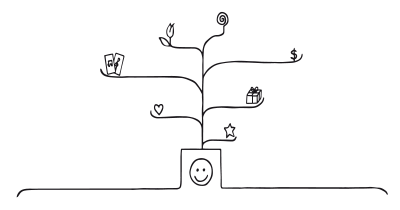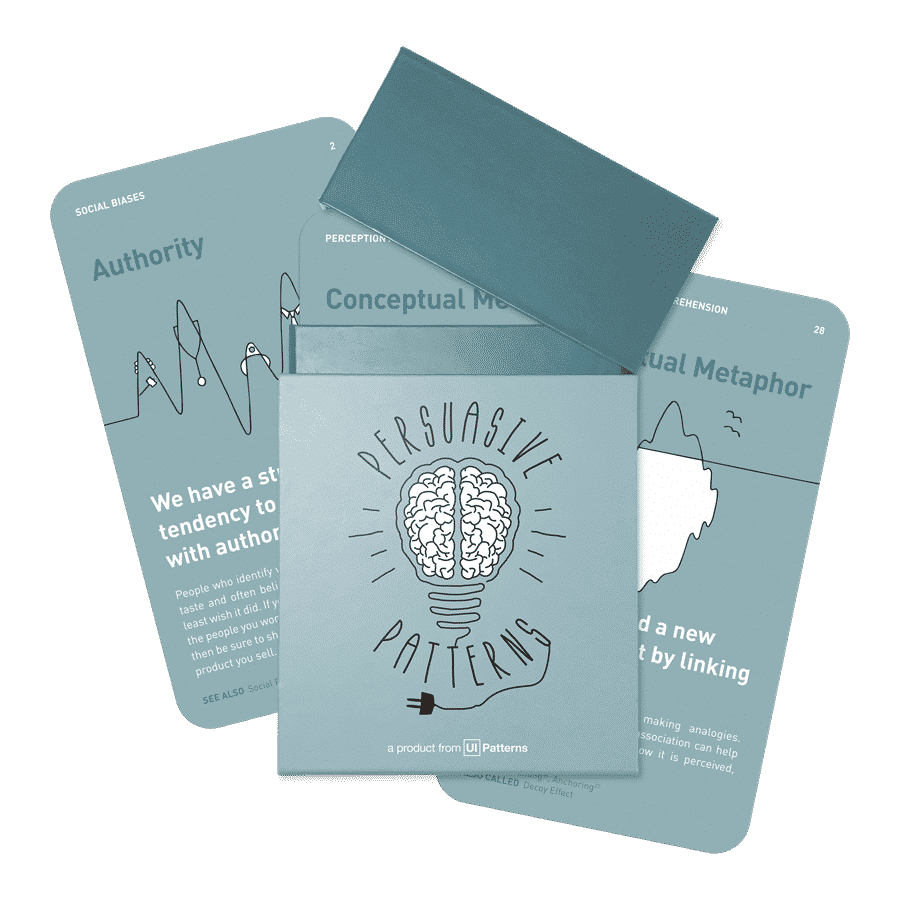Persuasive Technique
Also called: Novelty & Surprise
See also: Achievements, Delighters, Humor Effect, Levels, Peak-End Rule, Rewards, Status, Storytelling, Tailoring, Triggers
This persuasive pattern is part of the Persuasive Patterns printed card deck.
The Persuasive Patterns Card Deck is a collection of 60 design patterns driven by psychology, presented in a manner easily referenced and used as a brainstorming tool.
Get your deck!Delighters refer to elements within a product or service that provide unexpected joy or surprise to the user. These features go beyond basic functionality to offer something novel or playful that enhances the overall user experience.
Consider an ordinary Tuesday afternoon. You’re running errands, and the day feels like a typical grind. As you wait in line at the grocery store, you absentmindedly check your phone. Suddenly, you receive a notification on your banking app. An unexpected message informs you that you’ve been credited with a small cashback reward for a recent purchase you barely remember. This unexpected delight, though minor, instantly brightens your day. The positive surprise disrupts the monotony of your routine, transforming a mundane chore into a slightly more enjoyable experience.
This delightful surprise translates directly to the digital world. Imagine using a ride-hailing app to get home from work. After you book your ride, the app displays a notification informing you that your driver is bringing you a complimentary bottle of water on a hot day. This unexpected gesture, while seemingly insignificant, can significantly enhance your experience with the app. The delightful surprise fosters a sense of goodwill and strengthens your positive perception of the service.
A positive surprise can amplify the feelings of joy
A seminal study conducted by psychologists Kahneman and Tversky sheds light on the power of unexpected rewards. The study involved participants playing a simple game where they could win or lose money. Interestingly, the researchers found that the pleasure of gaining money was significantly less intense than the disappointment of losing the same amount. However, when the researchers introduced an unexpected element – the chance to win double the amount – the positive surprise significantly amplified the feelings of joy experienced by the participants.
This study reveals the power of unexpected rewards in intensifying positive emotions. By incorporating “Delighters” into product design, we can leverage this well-established psychological principle to create user experiences that are not only functional but also unexpectedly delightful.
Kahneman, D., & Tversky, A. (1979). Prospect theory: An analysis of decision under risk. Econometrica, 47(2), 263–291.
Delighters taps into the psychological principle of reward positivity. Our brains are wired to prioritize and remember positive experiences more vividly than negative ones. This phenomenon, known as the positivity bias, explains why unexpected moments of joy can leave a lasting impression.
Delighters create unexpected joy, which leads to memorable experiences that can positively affect a user’s overall perception of a product or service. These unexpected pleasures trigger a release of dopamine, a neurotransmitter associated with feelings of pleasure and satisfaction, reinforcing the behavior that led to the delightful experience.
By tapping into this mechanism, the Delighters pattern leverages the novelty and surprise to not only satisfy but exceed expectations, making the experience stand out in the user’s memory. This is particularly important in today’s competitive markets, where simply meeting customer expectations may no longer be sufficient to retain loyalty. Engaging users with delightful elements helps in creating a deeper emotional connection, enhancing the perceived value of the product or service and fostering a strong, positive relationship between the user and the brand.
This principle is consistent with theories that emphasize the importance of emotions in decision-making and behavior, suggesting that positive experiences can lead to higher engagement and retention rates. Thus, implementing Delighters effectively can be a crucial strategy in enhancing user engagement and promoting positive user behavior.
Designing products with Delighters
The effectiveness of Delighters hinges on surprise and relevance. Conduct user research to identify moments in the user journey where a delightful surprise would be most impactful. Consider user demographics, preferences, and pain points to tailor the delight to resonate with your target audience.
Powerful Delighters keeps an element of surprise. Avoid turning delightful surprises into predictable occurrences. Balance the use of delightful features with the core functionalities of your product to ensure they remain unexpected and impactful.
A delightful surprise for one user might be mundane for another. Consider offering a variety of delightful experiences to cater to different user preferences. This could involve customization options or the ability to unlock new delightful features as users progress through the product.
Delights don’t need to be grand gestures. Sometimes, a subtle touch of whimsy or a playful animation can be enough to create a positive emotional response. Focus on creating a delightful experience that complements your product’s overall aesthetic and user experience.
Delighters don’t have to be grand gestures. Small surprises can often lead to big impacts. For example, a playful animation after a user completes a task, unexpected praise or rewards for routine actions, or a humorous error message can transform user perception.
The Kano model
The concept of Delighters in user experience and product design can be traced back to Noriaki Kano’s model developed in the 1980s. Originally applied to product development and customer satisfaction, Kano identified features that could significantly enhance customer delight unexpectedly. These features, termed ‘Delighters’, go beyond satisfying basic customer needs and offer something unexpectedly pleasurable that can create strong emotional connections with the product.
The Kano model distinguishes among three types of product features: Must-Be, Performance, and Delighters. These categories help designers and product managers understand how different aspects of their product can influence user satisfaction and loyalty.
- Must-be features
These are the basic features that customers expect from a product. Their absence causes dissatisfaction, but their presence doesn’t significantly increase customer satisfaction. They are taken for granted when fulfilled. - Performance features
These features result in satisfaction when performance is high, and dissatisfaction when performance is low. They are typically the features that companies compete on, as customers are explicitly aware of them and their performance. - Delighters (Attractive Features)
These features provide a high degree of satisfaction when present, but their absence does not cause dissatisfaction because customers do not expect them. Delighters can convert users into passionate advocates for the product and can significantly enhance customer loyalty.
In the context of product design, Delighters play a critical role in differentiating a product from its competitors. They are often unexpected features that elicit positive emotional responses from users, such as joy, surprise, or even delight, thus creating memorable experiences. These features can include innovative functionalities, personalized interactions, or aesthetic enhancements that are not anticipated but are highly appreciated when discovered.
While Delighters can significantly enhance user satisfaction, they should be used strategically. They must align with the overall user experience and should not overwhelm the core functionalities with frivolities. Their use should also be sustainable within the business context, adding value without incurring disproportionate costs.
Ethical recommendations
In digital environments like gaming or social media, where dopamine-driven feedback loops can result in compulsive behavior patterns. Additionally, delighters that are not transparent, such as hidden costs after an initial delightful experience, can lead to user distrust and frustration once the underlying costs become apparent.
Other unethical practices include using delightful surprises to nudge users towards unhealthy behaviors, like excessive gambling or in-app purchases..Overreliance on delightful surprises can distract users from core functionalities of the product. Rather, the user experience should prioritize ease of use and clear value proposition.
- Be transparent
Be open about what users can expect from their interactions with your product. Any delightful experience offered should be clear in its intentions and outcomes to prevent users from feeling deceived. - Maintain a healthy balance
While delighters can significantly enhance user experience, they should not distract from or undermine the core functionality of the product. Ensure that these elements add genuine value and do not solely serve as a means to obscure deficiencies or manipulate behavior. - Give the user control
Allow users to opt-out of potentially intrusive or unwelcome delightful experiences. Giving users control over their interactions fosters trust and respects individual preferences. - Design positive experiences
Design delighters that promote positive reinforcement without encouraging negative behaviors. Avoid using psychological triggers that could lead to addiction or negative emotional responses.
Align delighters with the overall well-being of users. Any design element that contributes to a sense of joy or satisfaction should also support the user’s long-term well-being and not just short-term pleasure.
Examples
Google Doodles
Google regularly transforms its homepage logo into creative, fun doodles commemorating holidays, anniversaries, and the lives of famous artists and scientists. These doodles surprise and delight users globally, enhancing engagement and brand affinity.
Slack
Slack uses delightful micro-interactions, like customizable loading messages and playful animations for certain commands, which enhance user experience by infusing humor and personality.
Zappos
Known for excellent customer service, Zappos occasionally surprises customers with unexpected free upgrades to overnight shipping, delighting customers and building brand loyalty.
Trigger Questions
- How can we ensure our delighters remain unexpected and fresh?
- Are the delighters we plan to implement aligned with our brand identity and user expectations?
- What are subtle ways we can integrate delighters without overwhelming the user experience?
- How can we measure the effectiveness of our delightful surprises?
- What feedback mechanisms can we introduce to assess whether delighters continue to be effective?
- How can we balance core functionality with delightful elements to maintain or enhance overall user experience?
- How can we ensure delights remain delightful and avoid becoming predictable?
- What subtle touches can create a delightful and engaging experience?
Pairings
Delighters + Rewards + Achievements
Delighters work well with the Rewards pattern, where unexpected bonuses can enhance the joy of achievements. For example, a fitness app could surprise users who reach their weekly goals earlier than expected with a special badge or a one-time discount on premium gear.

We remember and respond favorably to new, unexpected, and playful pleasures

Use rewards to encourage continuation of wanted behavior

We are engaged by activities in which meaningful achievements are recognized
Delighters + Peak-End Rule
This rule states that people judge an experience by its most intense point and its end. Delighters can be strategically placed at the climax or conclusion of user interactions to create a memorable experience. For instance, a service could send a personalized thank-you video message from the CEO to clients at the end of a major project, exceeding expectations.

We remember and respond favorably to new, unexpected, and playful pleasures

We judge an experience by its peak and how it ends
Delighters + Status + Levels
Integrating Delighters with status-based features encourages continuous engagement. For example, upon reaching a new status level, users could unlock hidden features or content that delight and motivate further interaction.

We remember and respond favorably to new, unexpected, and playful pleasures

We constantly look to how our actions improve or impair how others see us

Use levels to communicate progress and gauge users' personal development
Delighters + Tailoring
Personalized Delighters based on user data (likes, past behaviors, preferences) can make experiences feel more individualized and unexpected. A music streaming service could delight users by creating and offering personalized playlists unexpectedly.

We remember and respond favorably to new, unexpected, and playful pleasures

Adapt the offerings of a system to match individual users- needs and abilities
Delighters + Storytelling
A travel booking app (e.g., Airbnb) could surprise users with a hidden “mystery deal” on a weekend getaway, presented within a captivating travel story. This unexpected delight sparks user interest and injects a touch of playful discovery into the booking process.

We remember and respond favorably to new, unexpected, and playful pleasures

We engage, understand, and remember narratives better than facts alone
This persuasive pattern is part of the Persuasive Patterns printed card deck.
The Persuasive Patterns Card Deck is a collection of 60 design patterns driven by psychology, presented in a manner easily referenced and used as a brainstorming tool.
Get your deck!- Surprise as a design strategy by Ludden, Schifferstein & Hekket
- Intrinsic Motivation and Self-Determination in Human Behavior by Deci & Ryan
- Van Osselaer, S., & Janiszewski, C. (2011). The persuasive effects of unexpected in-store promotions. Journal of Marketing, 75(6), 104–120.
- Shankar, V., Inman, J. J., Smith, D. C., & Chaudhuri, A. (2008). Brand and product knowledge effects on consumer evaluations of unexpected service encounters. Journal of Consumer Psychology, 18(1), 74–84.
- Baumeister, R. F., Bratslavsky, E., Finkenauer, C., & Vohs, K. D. (2001). Bad is stronger than good. Review of Personality and Social Psychology, 4(1), 3–17.
- Kahneman, D., & Tversky, A. (1979). Prospect theory: An analysis of decision under risk. Econometrica, 47(2), 263–291.
- Kano, N., Seraku, N., Takahashi, F., & Tsuji, S. (1984). Attractive quality and must-be quality. Journal of the Japanese Society for Quality Control, 14(2), 39-48.
- Lerner, J. S., Li, Y., Valdesolo, P., & Kassam, K. S. (2015). Emotion and Decision Making. Annual Review of Psychology, 66, 799-823.
